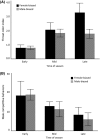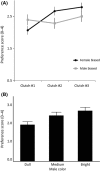Flexible mate choice when mates are rare and time is short
- PMID: 24101975
- PMCID: PMC3790532
- DOI: 10.1002/ece3.666
Flexible mate choice when mates are rare and time is short
Abstract
Female mate choice is much more dynamic than we once thought. Mating decisions depend on both intrinsic and extrinsic factors, and these two may interact with one another. In this study, we investigate how responses to the social mating environment (extrinsic) change as individuals age (intrinsic). We first conducted a field survey to examine the extent of natural variation in mate availability in a population of threespine sticklebacks. We then manipulated the sex ratio in the laboratory to determine the impact of variation in mate availability on sexual signaling, competition, and mating decisions that are made throughout life. Field surveys revealed within season heterogeneity in mate availability across breeding sites, providing evidence for the variation necessary for the evolution of plastic preferences. In our laboratory study, males from both female-biased and male-biased treatments invested most in sexual signaling late in life, although they competed most early in life. Females became more responsive to courtship over time, and those experiencing female-biased, but not male-biased sex ratios, relaxed their mating decisions late in life. Our results suggest that social experience and age interact to affect sexual signaling and female mating decisions. Flexible behavior could mediate the potentially negative effects of environmental change on population viability, allowing reproductive success even when preferred mates are rare.
Keywords: Age; mate choice; operational sex ratio; plasticity; stickleback.
Figures





Similar articles
-
The evolution of male mate choice in insects: a synthesis of ideas and evidence.Biol Rev Camb Philos Soc. 2001 Aug;76(3):305-39. doi: 10.1017/s1464793101005693. Biol Rev Camb Philos Soc. 2001. PMID: 11569787 Review.
-
Does competition allow male mate choosiness in threespine sticklebacks?Am Nat. 2009 Feb;173(2):273-7. doi: 10.1086/595753. Am Nat. 2009. PMID: 19117472
-
Females sample more males at high nesting densities, but ultimately obtain less attractive mates.BMC Evol Biol. 2015 Sep 18;15:200. doi: 10.1186/s12862-015-0481-3. BMC Evol Biol. 2015. PMID: 26385337 Free PMC article.
-
Seasonal variation in female mate choice and operational sex ratio in wild populations of an annual fish, Austrolebias reicherti.PLoS One. 2014 Jul 16;9(7):e101649. doi: 10.1371/journal.pone.0101649. eCollection 2014. PLoS One. 2014. PMID: 25029019 Free PMC article.
-
Variation in mate choice and mating preferences: a review of causes and consequences.Biol Rev Camb Philos Soc. 1997 May;72(2):283-327. doi: 10.1017/s0006323196005014. Biol Rev Camb Philos Soc. 1997. PMID: 9155244 Review.
Cited by
-
Personality traits change after an opportunity to mate.Proc Biol Sci. 2020 May 13;287(1926):20192936. doi: 10.1098/rspb.2019.2936. Epub 2020 Apr 29. Proc Biol Sci. 2020. PMID: 32345156 Free PMC article.
-
Sex differences in cognition and their relationship to male mate choice.Curr Zool. 2019 Jun;65(3):285-293. doi: 10.1093/cz/zoz014. Epub 2019 Apr 2. Curr Zool. 2019. PMID: 31263487 Free PMC article.
-
Veiled preferences and cryptic female choice could underlie the origin of novel sexual traits.Biol Lett. 2019 Feb 28;15(2):20180878. doi: 10.1098/rsbl.2018.0878. Biol Lett. 2019. PMID: 30958124 Free PMC article.
-
Premating isolation is determined by larval rearing substrates in cactophilic Drosophila mojavensis. X. Age-specific dynamics of adult epicuticular hydrocarbon expression in response to different host plants.Ecol Evol. 2014 Jun;4(11):2033-45. doi: 10.1002/ece3.1088. Epub 2014 Apr 23. Ecol Evol. 2014. PMID: 25360246 Free PMC article.
-
Context matters: sexual signaling loss in digital organisms.Ecol Evol. 2015 Sep;5(17):3725-36. doi: 10.1002/ece3.1631. Epub 2015 Aug 18. Ecol Evol. 2015. PMID: 26380700 Free PMC article.
References
-
- Albert AYK, Millar NP, Schluter D. Character displacement of male nuptial colour in the threespine sticklebacks (Gasterosteus aculeatus. Biol. J. Linn. Soc. 2007;91:37–48.
-
- Andersson M. Sexual selection. Princeton Univ. Press; 1994.
-
- Bakker TCM. Positive genetic correlation between female preference and preferred male ornament in sticklebacks. Nature. 1993;363:255–257.
LinkOut - more resources
Full Text Sources
Other Literature Sources

